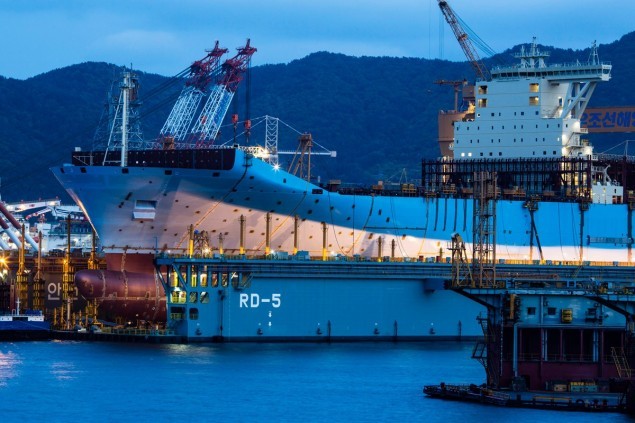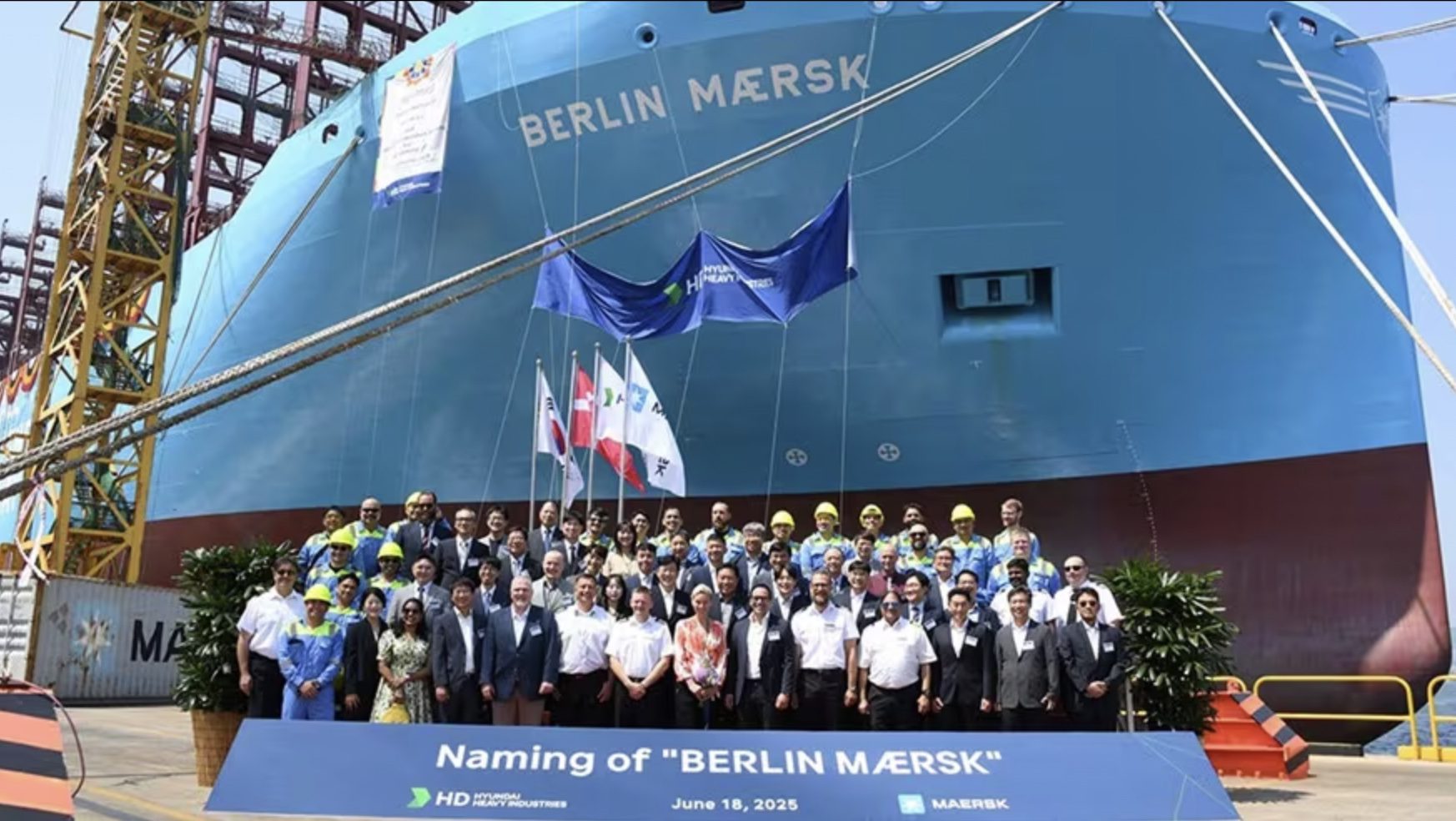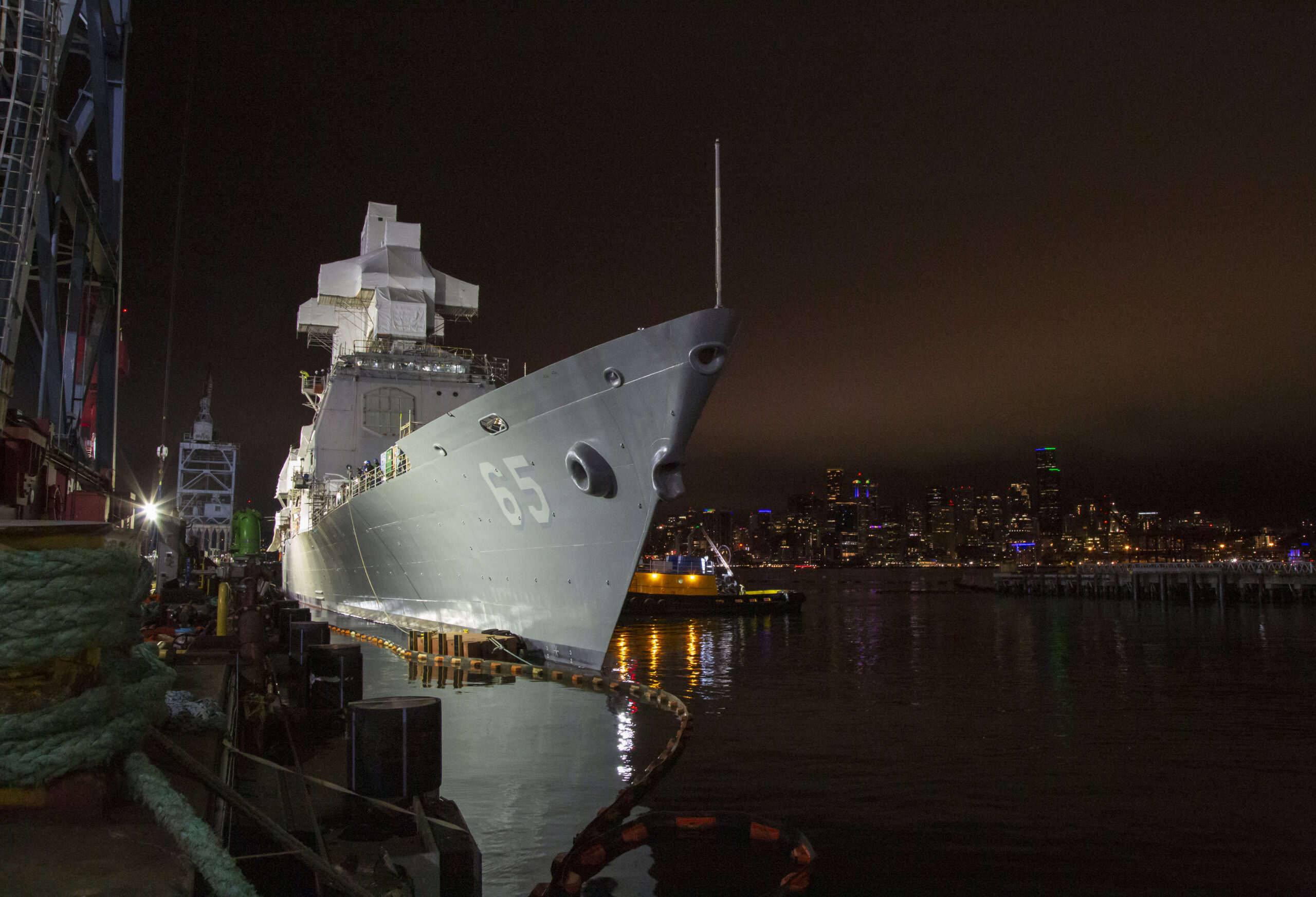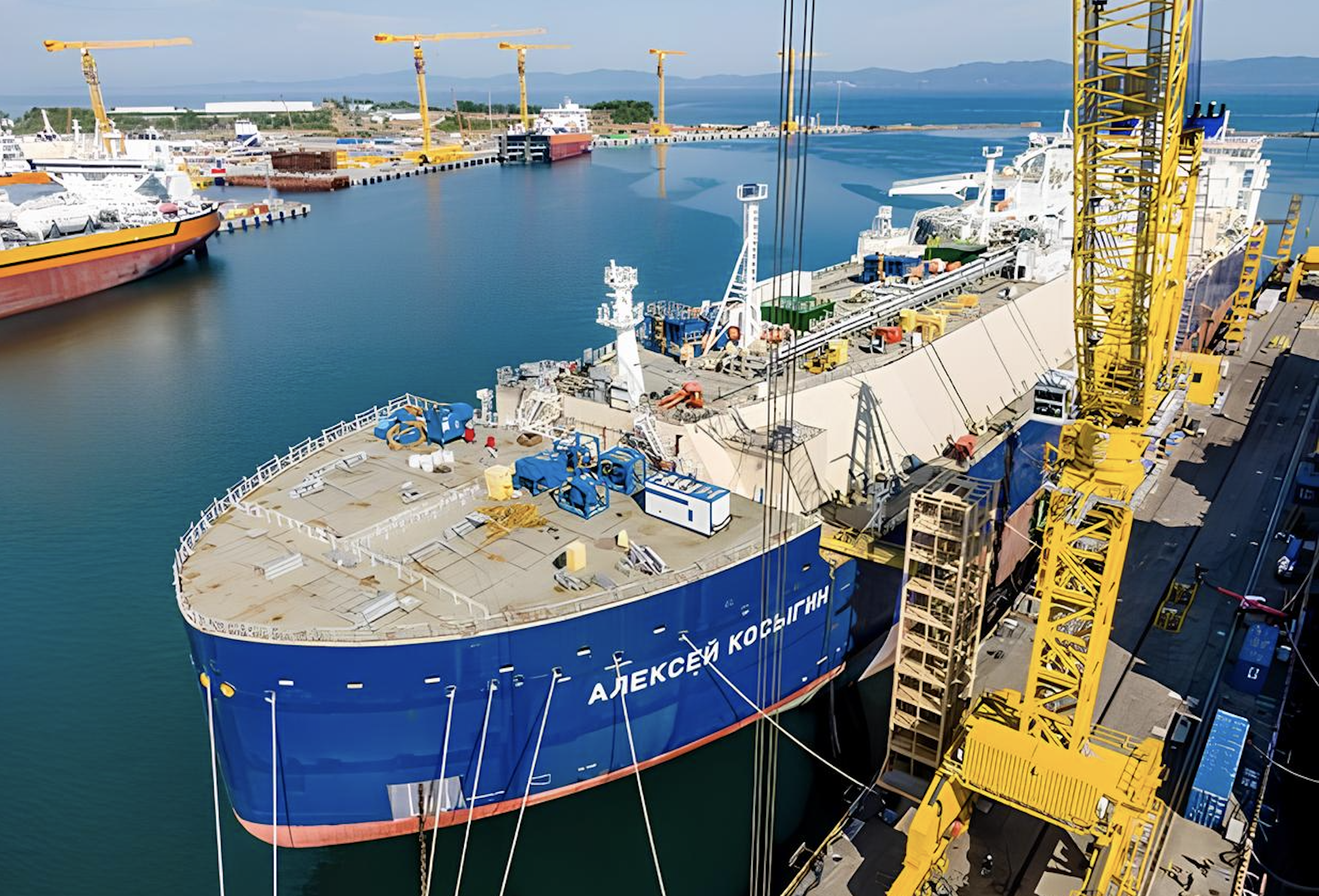Sunset Photo of a Maersk Triple-E class ship under construction at DSME shipyard, Geoje, South Korea. Photo by Thorb Hansen, Maersk
Forty-thousand alarm clocks buzzed as one, waking an equal number of workers for work at Daewoo Shipbuilding & Marine Engineering (DSME), the world’s second-largest shipyard, just before dawn on Geoje Island, along South Korea’s southwest coast. As the sun rose, they marched out for another day’s labor at the company’s immense dry docks, dominated by the soaring arc of a Brobdingnagian hull. Giant barge mounted cranes float past the docks, where they had laid each mega-block section, enormous, pre-fabricated ship segments onto a blacktop larger than a Walmart parking lot.

The enormous ship, due for launch on June 28, is the world’s biggest. A behemoth even in a world of behemoths, and the first sibling in a new fleet of 19 sisterships. The vessel will have the ability to carry 18,000 twenty foot shipping containers and will weigh-in at 165,000 metric tons, the equivalent mass of all the gold ever mined.
Sheer size is her most distinguishing feature. At 400 meters, the M/V Maersk Mc-Kinney Møller, as she’ll be called, is significantly longer than any aircraft carrier or even the Titanic, and only slightly shorter than the Empire State Building is high. Standing on her bridge is like peering over the rim of the Grand Canyon. From her highest deck, shipyard workers resemble overgrown ants and officers needing to walk the bridge’s width, wing-to-wing, will wish they had packed roller skates.
Why so large?

The M/V Maersk Mc-Kinney Møller, first vessel of the A.P. Moller-Maersk Group’s new Triple-E class container ships, leverages unprecedented economies of scale and energy efficiency, as well as a new generation of environmental safeguards. Its sheer size helps maximize each of these factors while reducing the cost and environmental impact of shipping each container.
Costing just under $200 million to build, the ship is powered by two engines, each one diminutive compared to the single 109,000-horsepower diesel of the Emma Maersk, the largest container ship in the world when it was launched in 2006. And the new ship’s cost, high as it seems, is only one-fifth the price of the Floating Production Storage Offloading (FPSO) vessels the offshore oil and gas industry uses to store and process oil, or less than 7% the cost of one Prelude Class FLNG.
Colossal Scale, Pinpoint Precision
Despite its size, the M/V Maersk Mc-Kinney Møller was built with pinpoint precision. “Construction of the ship was a massive international effort,” said Peter Bertelsen, Lead Hull Superintendant for Maersk. “But it’s not rocket science, just a big puzzle, a 3-D puzzle.” Each of the ship’s 31 pre-fabricated mega-sections were lifted by a giant scissor lift crane then dropped into the dry dock and neatly aligned to within four millimeters of the adjacent block.
About 250 people work on each ship during the final stages of construction, according to Bertelsen and Y.S. Lee, his DSME counterpart, with few tasks automated. “The steel is cut by giant, computer-operated lasers, but the rest is done by human hands,” said Lee. “Each section is moved into place using hand signals and radios and the sections are welded together by dozens of individual welders.”
Acquiring the colossal sections, however, required the efforts of thousands of laborers who ordered, built and moved the millions of individual parts within each monster slice. DSME’s facility in Shandong, China- one of three shipyards building the M/V Maersk’s megablocks- constructed 40 percent of the sections, which heavy lift ships then transported to Goeje Island.
At Goeje, operators of the yard’s giant cranes and transporters secure each section into place.
The M/V Maersk Mc-Kinney Møller, despite its record-busting bulk, is fitted with standard equipment. The lifeboats (made in China) are small and the bridge systems, while modern, are less impressive than those found aboard the latest Offshore Supply Vessels. The captain will occupy a comfortable suite adjoining the bridge that consists of a cabin, a day room and an office. But each room — cozy, not spacious — is no larger than a single crew cabin.
The vessel’s top speed is 23 knots, a bit slower than the design speed of older, smaller container ships which did not contend with the issue of an over-built containership industry, or extremely expensive fuel.
Invisible Achievements
The M/V Maersk’s principal achievements lie in benefits invisible to all but accountants, naval architects and environmental experts, but the cumulative results are outstanding. Triple-E vessels will travel 184 kilometres using 1 kWh of energy per ton of cargo, whereas a jumbo jet travels half a kilometre using the same amount of energy per ton.
The savings are the result of a unique hull design, an energy-efficient engine, a waste heat recovery system, which uses exhaust gas to produce extra energy to help propel the ship, and a vast economy of scale. Combined, these factors denote that the Triple-E will emit 20 percent less CO2 (per container moved) compared to the Emma Maersk and 50% less than the industry average on the Asia-Europe trade lane.
World Record Size
With a sailing draft of 14.5 meters (48′) she is too deep for most American ports and according to Maersk, the vessel will be calling on just 13 ports, all located in Asia and Northern Europe. The vessel is also too large for even the expanded Panama Canal, but is well within the maximum 20 meter draft and 77.5 meter beam requirements for vessels sailing through the Suez Canal.
The ship is certainly impressive but is not the largest ship ever built, that honor goes to the Knock Nevis, a 458 meter ULCC supertanker scrapped in 2010. She is expected to be listed in the next year’s Guinness Book of World Records, though she will not hold the world’s biggest ship distinction for long. At 400 meters she is 88 meters shorter in length than the Shell Prelude FLNG already under construction across the island at Samsung Heavy Industries, and she displaces close to half the water of the impressive dual-hulled heavy-lift pipelay vesseel, sip Pieter Schelte which was recently launched at DSME.
Regardless of competition, new and old, the M/V Mærsk McKinney-Møller is a thoroughly impressive vessel that will dwarf most other ships including America’s largest aircraft carriers.
For behind the scenes Photos And Videos of the Triple-E visit: Mærsk McKinney-Møller – Meet The World’s Largest Ship!
For gCaptain’s full coverage of the Triple-E visit: Maersk Triple-E Archives
By John Konrad, a captain and founder of the world’s leading maritime blog, gCaptain.com. His latest book is Fire on the Horizon: The Untold Story of the Gulf Oil Disaster, a non-fiction bestseller written with Tom Shroder. Edited by Stan Pinkwas.

 Join The Club
Join The Club













